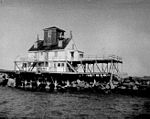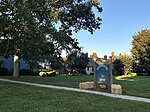Fisher's Paradise
Delaware Registered Historic Place stubsHouses completed in 1780Houses in Lewes, DelawareHouses on the National Register of Historic Places in DelawareNational Register of Historic Places in Sussex County, Delaware ... and 1 more
Use mdy dates from August 2023

Fisher's Paradise, also known as Paradise Point , is a historic home located near Lewes, Sussex County, Delaware. The main house dates to about 1780, and is a 2+1⁄2-story, three-bay, wood frame dwelling sheathed in cedar shingles. It has gable roof with dormers. The kitchen wing is the sole remaining portion of the original 1740s house that is incorporated in the present structure.It was added to the National Register of Historic Places in 1972.
Excerpt from the Wikipedia article Fisher's Paradise (License: CC BY-SA 3.0, Authors, Images).Fisher's Paradise
Pilottown Road,
Geographical coordinates (GPS) Address Website Nearby Places Show on map
Geographical coordinates (GPS)
| Latitude | Longitude |
|---|---|
| N 38.783611111111 ° | E -75.157222222222 ° |
Address
University of Delaware - College of Earth, Ocean and Environment
Pilottown Road 700
19958
Delaware, United States
Open on Google Maps









